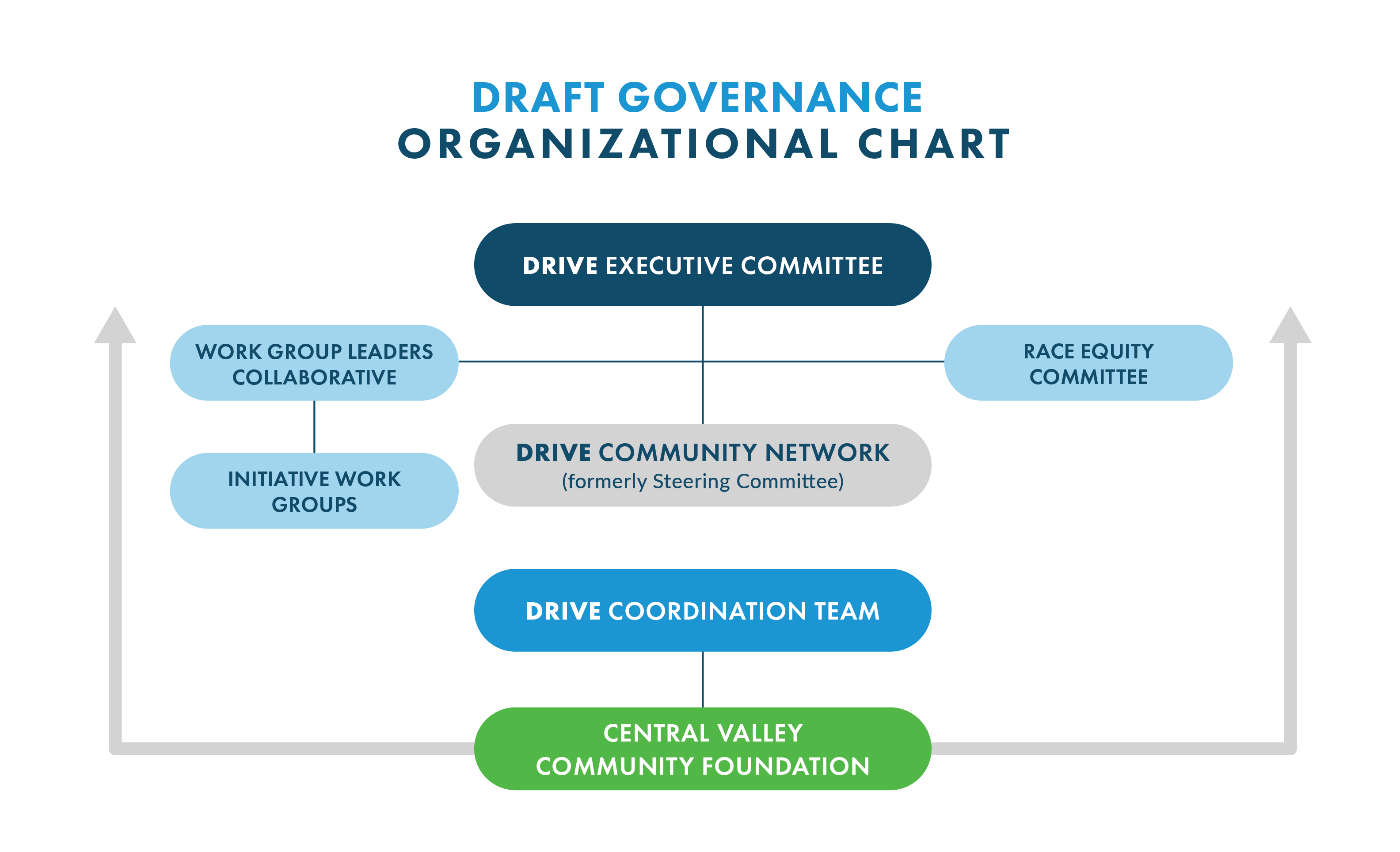
Local economic and community development initiatives often fail to meaningfully engage communities of color and communities with lower incomes, which limits their effectiveness in responding to residents’ priorities. Correcting decades of disinvestment, economic inequality, environmental injustice, and other consequences of structural racism requires embedding residents within the formal governance structure of local initiatives. Doing so, and following proven community-engaged methods, can elevate resident voices and lead to equitable development efforts that reflect community priorities.
Over the past 15 months, the Central Valley Community Foundation (CVCF) transformed the governance structure of the Fresno DRIVE (Developing the Region’s Inclusive and Vibrant Economy) initiative to better reflect the community members it serves. Their approach to resident leadership offers policymakers, practitioners, and their partners a strong example of inclusive, economic growth.
Lessons from Fresno DRIVE on creating an inclusive governance structure
A 2018 Urban Institute report illuminated the stark inequities in Fresno, California. The report ranked the city 253rd out of 274 US cities in overall inclusion, 55th out of 59 California cities in overall economic health, and last among California cities in economic racial inclusion. The research also showed the region will need 60,000 new, high-quality jobs to support Fresno’s population of 544,000.
These insights sparked the development of DRIVE, which CVCF launched in 2019. Initially governed by a 300-person steering committee representing 150 local and regional organizations, DRIVE is a 10-year strategy to advance a vibrant and equitable economy in California’s Central Valley. Although DRIVE built quick momentum, CVCF realized they had neglected to meaningfully involve residents and other community leaders whose insights are critical to the success of community and economic development efforts.
In 2022, CVCF underwent an extensive revamp of DRIVE’s governance structure to prioritize resident leadership. Since 2018, the Urban Institute has been working with Fresno DRIVE as part of the Shared Prosperity Partnershipto explore critical insights and share DRIVE’s lessons with other cities. Below we detail insights from DRIVE’s recent revamp.
- Form dedicated working groups and identify a neutral facilitator
Although DRIVE’s initial work engaged key institutional and organizational leaders, it lacked the community and resident perspectives in shaping the programs outlined in its 14 initiatives. To rectify this, CVCF started a working group in 2021 and engaged a neutral facilitator who had experience working with communities and local leaders on inclusion, power, and governance to manage the process, set the tone for difficult conversations, and help the committee design an inclusive structure.
Over four months, the Governance Committee built out recommendations that formalized the roles and responsibilities for DRIVE’s Executive Committee, Race Equity Committee, Work Group Leaders Collaborative, DRIVE Community Network, and DRIVE Coordination Team. By articulating how these groups should work together, this new DRIVE governance framework could elevate community voices and help improve implementation of DRIVE’s goals and theory of change.

- Adopt core principles that reflect shared values
With the help of the facilitator, the committee developed nine principles to ground the effort: sense of urgency, transparency, “power with,” constant learning mode, accountability and support, governance that reflects the community, space for new communication and collaboration, no special interests, and adaptability.
The committee also adopted the “right relationship” ethos, which they defined as: “All participants seek, without abandoning their own interests, to be attentive and responsive to the interests and emotions of one another and to avoid the use of power to oppress, exploit, and manipulate.” The nine principles and the “right relationship” concept helped the group coalesce around a common purpose and set the parameters for ensuring ideas, conversations, and decisions were driven by equity and justice.
- Build a diverse and inclusive structure
To achieve DRIVE’s theory of change, the Governance Committee knew there needed to be robust leadership involvement by people of color who have been historically excluded from traditional positions of power and influence in the Fresno region. Thus, DRIVE’s Executive Committee changed from its original 50 members primarily from institutions and community-based organizations to 38 members, which included 21 community representatives and 17 portfolio representatives.
CVCF and the committee were intentional about who would make up that group. Resident leaders of local grassroots groups rose to the top of the list, as their communities represented the primary beneficiaries of DRIVE’s investment plans. CVCF also looked for staff from the community-based organizations that had deep connections to residents. And it was essential that resident members of the new DRIVE Executive Committee reflect the rich diversity of Fresno’s communities and neighborhoods, including diversity in ethnicity, gender, age, geography, gender and sexual orientation, and disability.
- Implement an inclusive recruitment and selection process
To ensure an inclusive process in selecting its community representatives, the Governance Committee did the following:
• created applications in five languages
• leveraged its network of community-based organizations to recruit interested grassroots leaders
• ensured traditionally excluded groups were made aware of the opportunity (e.g., the Punjabi, Muslim, Southeast Asian, Indigenous, undocumented, LGBTQ, and disabled populations)
• hosted virtual meetings so people could ask questions about the role of the DRIVE Executive Committee
• developed a neutral application scoring matrix with the DRIVE Race Equity Committee
• hosted virtual interviews for those that scored high in the initial rankings
• delegated the final selection decisions to the DRIVE Race Equity Committee
As a result of these efforts, the DRIVE Governance Committee reached its diversity goals, and the 38-member committee meets monthly. To address some of the barriers to engagement that people of color and people with low incomes face, CVCF and DRIVE will offer a voluntary payment for their engagement and provide translation and child care services at all future gatherings.
Without the valuable perspectives of those most harmed by broken economic systems, communities will never reach the goals of inclusive economic development and shared prosperity. By coming together in a collective impact process to work through these challenges, the Executive Committee will ensure DRIVE and its initiatives can address Fresno’s complex challenges more inclusively and equitably.
Let’s build a future where everyone, everywhere has the opportunity and power to thrive
Urban is more determined than ever to partner with changemakers to unlock opportunities that give people across the country a fair shot at reaching their fullest potential. Invest in Urban to power this type of work.